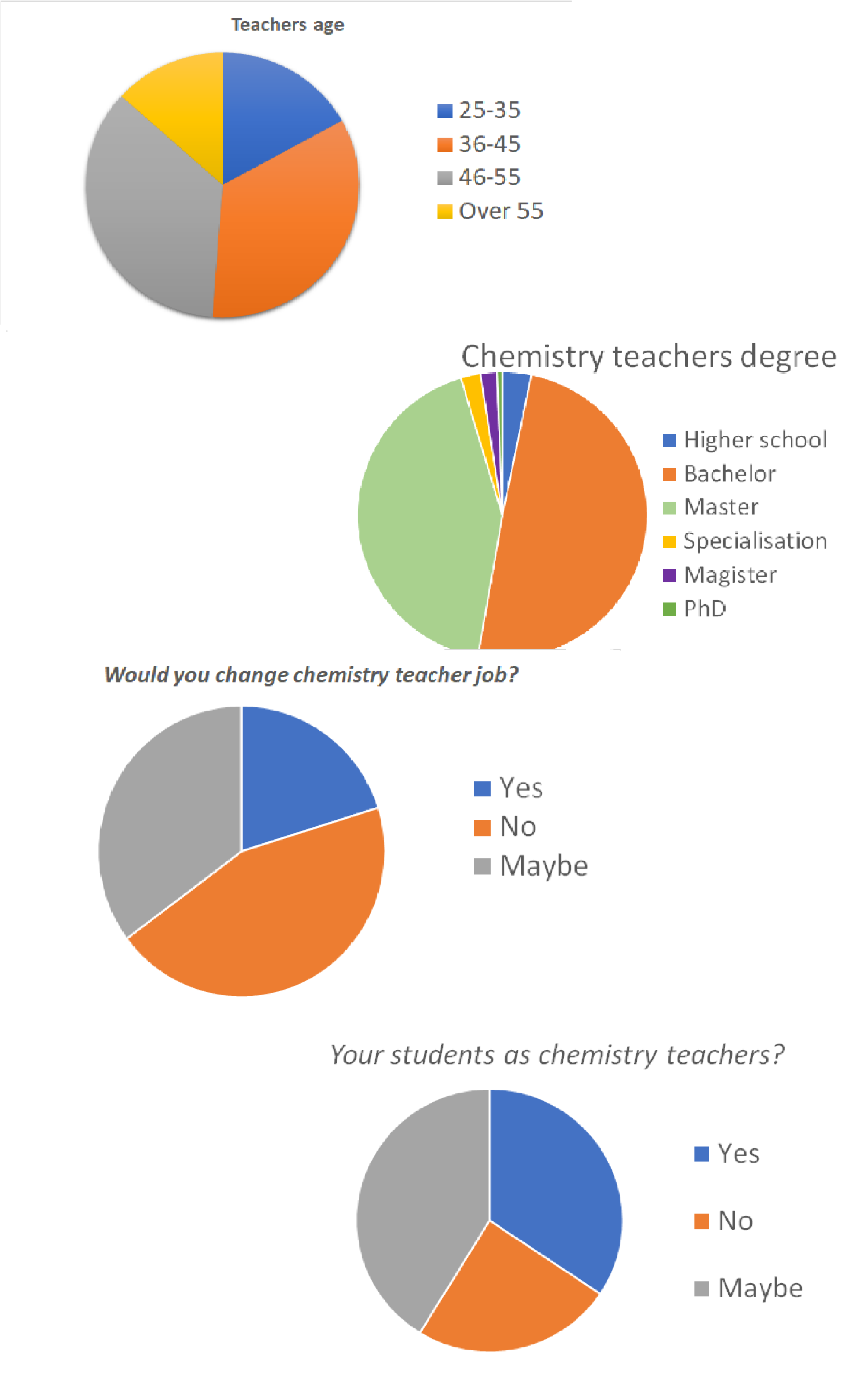Analysis of the initial education of chemistry teachers and their attitudes towards teaching in the Republic of Serbia Scientific paper
Main Article Content
Abstract
This research was aimed to analyse the current state in primary and secondary schools in the Republic of Serbia, regarding chemistry teachers’ initial education and self-perceived competencies. As an instrument, a questionnaire of 20 questions was used, which was prepared in the form of a Google questionnaire. The questions were divided into five groups to examine data on the structure of chemistry teachers (gender, age, place and school where they teach), the level of education obtained and the method of acquisition and acquired competencies, and finally the personal opinion of chemistry teachers about the teaching profession, advantages, disadvantages and possible recommendations to his/her students in terms of choosing this profession as a possible career. The questionnaire was sent to 1537 schools and 497 chemistry teachers took part in the questionnaire. The results showed that chemistry teachers are predominantly women, mostly aged 36–55, full-time employed and with an average working experience of over 11 years. Most teachers have appropriate education and acquired competencies. They cite working with children as the biggest advantage of the teaching profession while as the biggest disadvantage, they report a constant increase in the amount of administration from year to year.
Downloads
Metrics
Article Details

This work is licensed under a Creative Commons Attribution 4.0 International License.

Authors retain copyright and grant the journal right of first publication with the work simultaneously licensed under a Creative Commons Attribution license 4.0 that allows others to share the work with an acknowledgement of the work's authorship and initial publication in this journal.
Funding data
-
Ministarstvo Prosvete, Nauke i Tehnološkog Razvoja
Grant numbers 451-03-9/2021-14/200125
References
B. Cristina-Corina, A. Valerica, Procedia Soc. Behav. Sci. 51 (2012) 167 (https://doi.org/10.1016/j.sbspro.2012.08.139)
D. Popović in Montenegro in XXI Century — In The Era Of Competitiveness: Education, P. Vukotić, S. Milić, Ž. Jaćimović, V. Kašćelan, Z. Bogićević, D. Radonjić, R. Šendelj, D. Popović, T., Novović, Z. Minić, K. Popović, V.A., Lubarda, M. Popović, B. Šišević, Z. Kotri, Eds., Crnogorska akademija nauka i umjetnosti, Podgorica, Montenegro, 73, 2010, 239 (in Serbian) (https://canupub.me/bli3)
M. Danilović, in Proceedings of 6th International Symposium Technology, Informatics and Education for Learning and Knowledge Society, 2011, Čačak, Serbia, Tehnologija, informatika i obrazovanje, TIO 6, Tehnički fakultet, Čačak, 2011, 371.12 (in Serbian)
R. Deakin Crick, in Getting involved: Global citizenship development and sources of moral values, F. Oser, W. Veugelers, Eds., Sense Publishers, Rotterdam, 2008, p. 31
B. Tomašević, D. Trivić, J. Serb. Chem. Soc. 80 (2015) 435 (https://doi.org/10.2298/JSC141002121T)
L. S. Shulman, Educ. Researcher 15 (1986) 4 (https://doi.org/10.2307/1175860)
K. Lasić, Putokazi, 1(2019), 157 (in Serbian) (https://putokazi.eu/web/aktualni-broj/)
B. Tomašević, D. Trivić, Chem. Educ. Res. Pract. 15 (2014) 239 (https://doi.org/10.1039/C3RP00116D )
R.R. Edmonds, Search for effective schools: The identification and analysis of city schools that are instructionally effective for poor children (final report), Detroit, MI, 1977 (https://eric.ed.gov/?id=ED142610)
N. Oruç, Int. J. Humanit. Soc. Sci. 1 (2011) 83 (http://www.ijhssnet.com/journals/Vol._1_No._4;_April_2011/11.pdf)
V. Ferk Savec, B. Urankar, M. Aksela, I. Devetak, J. Serb. Chem. Soc. 82 (2017) 1193 (https://doi.org/10.2298/JSC161221083S)
K. Lasić, Putokazi 3 (2015) 101 (in Serbian) (https://putokazi.eu/wp-content/uploads/2015/03/KL.pdf)
G. Handley, Personality, learning and teaching, Routledge & K. Paul, London, 1973
H. Požar, Sinteze – časopis za pedagoške nauke, književnost i kulturu 5 (2016) 23 (https://doi.org/10.5937/sinteze0-11315) (in Serbian)
G. Đigić, PhD Thesis, Faculty of Philosophy, Niš, https://nardus.mpn.gov.rs/handle/123456789/4000 (accessed 28.11.2021) (in Serbian)
L. W. Anderson, D.R. Krathwohl, A taxonomy for learning, teaching, and assessing: A revision of Bloom's taxonomy of educational objectives, Longman, New York, 2001 (https://www.uky.edu/~rsand1/china2018/texts/Anderson-Krathwohl - A taxonomy for learning teaching and assessing.pdf)
K. Funda Nayir, S. Cinkir, Anthropologist 20 (2015) 1 (https://doi.org/10.1080/09720073.2015.11891718)
S. Stojiljković, Zbornik Instituta za pedagoška istraživanja 33 (2001) 190 (in Serbian) (https://www.ipisr.org.rs/images/arhiva-zbornika/Zbornik-33.pdf)
S. Stojiljković, Z. Dosković, Zbornik Instituta za pedagoška istraživanja 22 (1990) 63 (in Serbian) (https://www.ipisr.org.rs/images/arhiva-zbornika/Zbornik-22.pdf)
S. Stojiljković, Z. Dosković, Godišnjak za psihologiju 4 (2006) 237(in Serbian)
D. Ješić, Časopis za društvene i prirodne nauke 1 (2010) 195 (in Serbian) (https://www.psihologijanis.rs/arhiva-godisnjak/godisnjak-2005-2006/Godisnjak-Vol-4-No-4-5-%282005-2006%29-237-251.pdf)
V. Simeunović, P. Spasojević, Savremene didaktičke teme: nacrt za savremenu didaktičku koncepciju i strategiju nastavnog rada u osnovnoj školi, Pedagoški fakultet, Bijeljina, 2005 (in Serbian)
S. Stojiljkovic, Psihološke karakteristike nastavnika, Filozofski fakultet, Niš, 2012, (in Serbian)
E. M.Uslu, T. Özgün, Research on Education and Psychology 6 (2022) 68 (https://doi.org/10.54535/rep.1134110)
S. W. Wachanga, M. Ngary, D. R. Muchiri, ZJER 15 (2003) (https://opendocs.ids.ac.uk/opendocs/handle/20.500.12413/5376)
B. Scafidi, An analysis of the retention rates of Georgia public school teachers. The Governor’s Office of Student Achievement (accessed 30.11.2022 from www.gosa.georgia.gov)
OECD. TALIS 2018 Results (Volume II) Teachers and School Leaders as Valued Professionals (accessed 02.12.2022 from https://www.oecd-ilibrary.org/education/annex-bmain-breakdown-variables_d1ba43b3-en)
K. Bivona, Teacher moral: The impact of teaching experience, workplace conditions, and workload, 2002 (accessed 02.12.2022 from http://eric.ed.gov/?id=ED467760)
S. Black, Am. Sch. Board J. 190 (2003) 36 (https://eric.ed.gov/?id=EJ674597)
B. Tomašević, D. Trivić, Pedagogija 4(2014) 605 in Serbian
D. Sikošek, B. Čagran, J. Elementary Educ. 9 (2016) 75 (in Slovenian) (https://journals.um.si/index.php/education/article/view/351)
D. Can-Kucuk, S. Gencer, H. Akkus, Chem. Educ. Res. Pract. 123 (2022) 599 (https://doi.org/10.1039/d2rp00033d)
F. Longmuir, B. Gallo Cordoba, M. Phillips, K.A. Allen, M. Moharami, Australian Teachers’ Perceptions of their Work in 2022, Monash University, 2022 (https://doi.org/10.26180/21212891)
J. Copriady, Med. J. Soc. Sci. 5 (2014) 312 (https://dx.doi.org/10.5901/mjss.2014.v5n8p312)
L. Hargreaves, M. Cunningham, A. Hansen, D. McIntyre, C. Oliver, T. Pell, The status of teachers and the teaching profession in England: Views from inside and outside the profession, The Chancellor, Masters and Scholars of the University of Cambridge, Cambridge, 2007.





